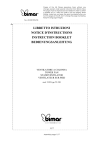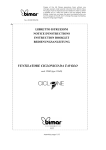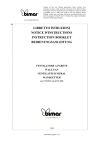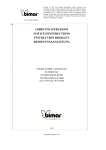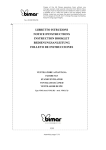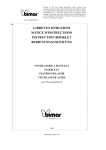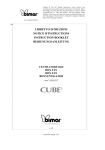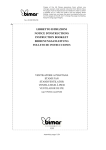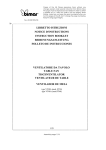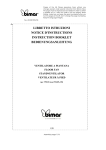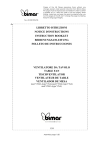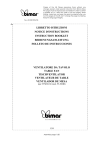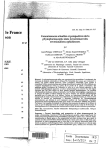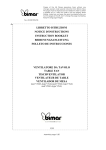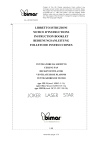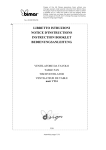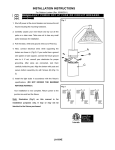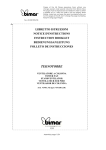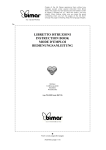Download libretto istruzioni notice d'instructions instruction booklet
Transcript
Copies of the I/B. Please reproduce them without any changes except under special instruction from Bimar (Italy). The pages must be reproduced and folded in order to obtain a booklet A5 (+/- 148.5 mm width x 210 mm height). When folding, make sure you keep the good numbering when you turn the pages of the I/B. Don’t change the page numbering. Keep the language integrity. Fax +32 030 9904733 LIBRETTO ISTRUZIONI NOTICE D'INSTRUCTIONS INSTRUCTION BOOKLET BEDIENUNGSANLEITUNG VENTILATORE A PIANTANA FLOOR FAN STANDVENTILATOR VENTILATEUR À PIED mod. VP56T (type RD-40AC) 1/16 Assembly page 1/16 Copies of the I/B. Please reproduce them without any changes except under special instruction from Bimar (Italy). The pages must be reproduced and folded in order to obtain a booklet A5 (+/- 148.5 mm width x 210 mm height). When folding, make sure you keep the good numbering when you turn the pages of the I/B. Don’t change the page numbering. Keep the language integrity. Fax +32 030 9904733 Questo simbolo vi invita a leggere attentamente queste istruzioni prima dell’uso dell’apparecchio, ed eventualmente informare terzi, se necessario. CONSERVARE IL LIBRETTO PER ULTERIORI CONSULTAZIONI. Questo simbolo vi invita a prestare attenzione, ed a leggere gli specifici avvertimenti sul libretto istruzioni. AVVERTENZE GENERALI • Questo apparecchio è destinato solo all’impiego domestico, per la ventilazione di ambienti interni: non utilizzatelo per altro scopo. Ogni altro uso è da considerarsi improprio e pericoloso. Il costruttore non potrà essere ritenuto responsabile di eventuali danni derivanti da uso improprio, erroneo e irresponsabile e/o da riparazioni effettuate da personale non qualificato. • Alcuni modelli possono essere corredati con porta aromi per la profumazione d’ambienti, ideali per uffici, soggiorni, ecc…Per diffondere gli aromi, inumidire con alcune gocce di oli/essenze (non inclusi) il filtro, senza eccedere nella quantità in modo da non danneggiare le vernici del ventilatore, per effetto dell’olio/liquido ossidante. Agganciare il porta aromi alla griglia anteriore o posteriore (comunque all’esterno) tramite i gancetti ricavati posteriormente. • Non infilare alcun utensile o le dita fra le maglie della griglia di protezione della ventola. • Non utilizzare l’apparecchio con temperatura ambiente superiore a 40°C. • L’apparecchio non è destinato a essere usato da persone (bambini compresi) le cui capacità fisiche, sensoriali o mentali siano ridotte, oppure con mancanza di esperienza o di conoscenza, a meno che esse abbiano potuto beneficiare, attraverso l’intermediazione di una persona responsabile della loro sicurezza, di una sorveglianza o di istruzioni riguardanti l’uso dell’apparecchio. I bambini devono essere sorvegliati per sincerarsi che non giochino con l’apparecchio. • L’apparecchio deve essere mantenuto fuori dalla portata di bambini. • Attenzione: quando si utilizzano apparecchi elettrici, occorre sempre rispettare le precauzioni di sicurezza di base per evitare i rischi di incendio, di scosse elettriche e di lesioni fisiche. • Non usare l’apparecchio se non funziona correttamente o se sembra danneggiato; in caso di dubbio rivolgersi a personale professionalmente qualificato. • Assicurarsi che la ventola funzioni correttamente: nel caso contrario spegnere l’apparecchio e farlo controllare da personale professionalmente qualificato. • Scollegare sempre l’apparecchio dalla presa di corrente prima di assemblare, smontare e prima di pulire l’apparecchio. • Non spostare l’apparecchio durante il funzionamento. • Se l’apparecchio non è in funzione togliere la spina dalla presa di corrente. • Non lasciare l’apparecchio esposto agli agenti atmosferici (sole, pioggia, ecc.). • Non toccare l’apparecchio con mani o piedi bagnati. • Non tirare il cavo per spostare l’apparecchio. • Non tirare il cavo d’alimentazione o l’apparecchio stesso per disinserire la spina dalla presa di corrente. • Se il cavo di alimentazione è danneggiato, esso deve sostituito dal costruttore o dal suo servizio assistenza tecnica o comunque da una persona con qualifica similare, in modo da prevenire ogni rischio. INSTALLAZIONE • Dopo aver tolto l’imballaggio, assicurarsi dell’integrità dell’apparecchio; in caso di dubbio non utilizzarlo e rivolgersi a personale professionalmente qualificato. Gli elementi d’imballaggio (sacchetti di plastica, polistirolo espanso, chiodi, ecc.) non devono essere lasciati alla portata di mano di bambini in quanto potenziali fonti di pericolo, ma vanno smaltiti secondo le norme vigenti negli appositi contenitori per la raccolta differenziata. Attenzione: eventuali adesivi o fogli pubblicitari applicati sull agriglia, devono essere rimossi prima dell’uso dell’apparecchio. • Prima di collegare l’apparecchio controllare che i valori di tensione riportati sulla targa dati corrispondano a quelli della rete elettrica. In caso di incompatibilità tra la presa e la spina dell’apparecchio, far sostituire la presa con altra di tipo adatto da personale professionalmente qualificato, il quale accerti che la sezione 2/16 Assembly page 2/16 Copies of the I/B. Please reproduce them without any changes except under special instruction from Bimar (Italy). The pages must be reproduced and folded in order to obtain a booklet A5 (+/- 148.5 mm width x 210 mm height). When folding, make sure you keep the good numbering when you turn the pages of the I/B. Don’t change the page numbering. Keep the language integrity. Fax +32 030 9904733 • • • • • • • dei cavi della presa sia idonea alla potenza assorbita dall’apparecchio. In generale è sconsigliato l’uso di adattatori e/o prolunghe; se il loro uso si rendesse indispensabile, devono essere conformi alle vigenti norme di sicurezza e la loro portata di corrente (ampères) non deve essere inferiore a quella massima dell’apparecchio. Prima di ogni utilizzo verificare che l’apparecchio sia in buono stato, che il cordone elettrico non sia danneggiato: in caso di dubbio rivolgersi a personale professionalmente qualificato. La presa di corrente deve essere facilmente accessibile in modo da poter disinserire con facilità la spina in caso di emergenza. Posizionare l’apparecchio lontano da: - fonti di calore (ad es. fiamme libere, fornello gas, ecc. ) - contenitori di liquidi (ad esempio, lavelli ecc.) per evitare schizzi d’acqua o che vi possa cadere (distanza minima 2 metri) La superficie di appoggio deve essere stabile, non in pendenza (in quanto l’apparecchio potrebbe ribaltarsi) e liscia. Questo apparecchio non è destinato a essere fatto funzionare per mezzo di un temporizzatore esterno o con un sistema di comando a distanza separato, per evitare il rischio di incendio nel caso l’apparecchio sia coperto o sia posizionato in modo non corretto. Non allacciare l’apparecchio a sistemi di controllo termico o programmatore o timer o ad altro dispositivo che possa accendere l’apparecchio automaticamente, evitando così rischi di danni a persone, animali o cose. In caso di guasto o cattivo funzionamento spegnere l’apparecchio e farlo controllare da personale professionalmente qualificato; le riparazioni effettuate da personale non qualificato possono essere pericolose e fanno decadere la garanzia. ASSEMBLAGGIO Attenzione: il ventilatore può essere utilizzato solo se completamente e correttamente assemblato, cioè completo di base e di griglia di protezione. Nel caso di dubbio far controllare o eseguire l’operazione da personale professionalmente qualificato. Per l’assemblaggio si prenda come riferimento la fig.1. Piantana 1) Incrociare i due piedi (9) e fissare a questi l’asta fissa (8) mediante le 4 viti in dotazione. 2) Svitare la ghiera fissaggio asta (10) e sfilarla; inserire il coperchio (11) per coprire le giunzioni tra i piedi e l’asta fissa. 3) Allungare l’asta regolabile (7) fino all’altezza desiderata e bloccarla avvitando in modo serrato la ghiera fissaggio asta (10) Ventilatore 1) Inserire la griglia posteriore (5) nel carter motore, e posizionarla in modo che i perni si inseriscano nei fori corrispondenti; bloccare mediante l’apposita ghiera (4). 2) Inserire la ventola (3) sull’albero motore (14), in modo che l’asola si accoppi alla chiavetta. Bloccare con l’apposita ghiera (2) avvitandola in senso antiorario in modo serrato. 3) Accoppiare la griglia anteriore (1) a quella posteriore (5) bloccandole con i ganci di tenuta. Ai fini della sicurezza è obbligatorio assicurare il fissaggio utilizzando l’apposita vite c/dado da impegnare nei fori presenti sul bordo delle griglie (i fori per la vite devono risultare nella parte inferiore). 4) Fissare il corpo del ventilatore alla piantana innestando il foro inferiore sull’asta regolabile della piantana, e bloccarlo serrando la vite fissaggio piantana (12). 3/16 Assembly page 3/16 Copies of the I/B. Please reproduce them without any changes except under special instruction from Bimar (Italy). The pages must be reproduced and folded in order to obtain a booklet A5 (+/- 148.5 mm width x 210 mm height). When folding, make sure you keep the good numbering when you turn the pages of the I/B. Don’t change the page numbering. Keep the language integrity. Fax +32 030 9904733 Fig.1 1) 2) 3) 4) 5) 6) 7) 8) 9) 10) 11) 12) 13) 14) Griglia anteriore/schermo di protezione Ghiera fissaggio ventola Ventola Ghiera fissaggio griglia Griglia posteriore Pannello comandi Asta regolabile Asta fissa Piedi Ghiera fissaggio asta Coperchio Vite fissaggio piantana Corpo Albero motore USO Prima di ogni utilizzo verificare che l’apparecchio sia in buono stato, che il cordone elettrico non sia danneggiato: se il cavo di alimentazione è danneggiato, esso deve sostituito dal costruttore o dal suo servizio assistenza tecnica o comunque da una persona con qualifica similare, in modo da prevenire ogni rischio. Le funzioni del ventilatore possono essere azionate sia con la pulsantiera posta sul pannello comandi (6), che col telecomando. Il telecomando deve essere puntato nella direzione del pannello comandi, e prima ancora bisogna inserirvi le batterie (aprire lo sportello posteriore e inserire due batterie tipo “AAA” rispettando la polarità. Richiudere lo sportello) Inserire la spina nella presa di corrente. Ventilazione: 1) Per accendere il ventilatore, premere il tasto “ON-SPEED” del telecomando o del pannello comandi. Il ventilatore si avvierà alla velocità minima. 2) Per selezionare la velocità desiderata, premere ripetutamente il tasto “ON-SPEED”: sul pannello comandi o del telecomando si illuminerà la spia corrispondente alla velocità selezionata (Low=minima, Mid=media, High= massima). Oscillazione orizzontale (destra-sinistra): si ottiene premendo l’apposito tasto “Swing” del telecomando o della pulsantiera: sul pannello comandi si illuminerà la spia corrispondente. Per eliminare il movimento premere nuovamente il tasto “Swing” ( la corrispondente spia si spegne). Inclinazione verticale (alto-basso): si regola impugnando il corpo motore e dirigendolo nella direzione desiderata; avvitare l’apposita vite (11) per bloccare il corpo motore nella posizione desiderata. Timer: questa funzione consente di impostare il tempo di funzionamento, al termine del quale l’apparecchio si arresta automaticamente. • Per impostare il tempo di funzionamento, premere ripetutamente il tasto “TIMER” del telecomando o del pannello comandi: ad ogni pressione del tasto varia il tempo impostato, e sul pannello comandi si illumina la spia luminosa corrispondente al tempo selezionato (0,5 ora- 1 ora - 2 ore - 4 ore ): il tempo massimo è di 7ore e 30’. • Per disattivare il timer, impostare il tempo massimo, quindi premere nuovamente il tasto “TIMER” (le corrispondenti spie si spengono). • Per spegnere il ventilatore, premere il tasto “OFF” presente sul telecomando o sul pannello comandi, poi disinserire la spina dalla presa di corrente. Per lunghi periodi di inattività, togliere la spina dalla presa di corrente. 4/16 Assembly page 4/16 Copies of the I/B. Please reproduce them without any changes except under special instruction from Bimar (Italy). The pages must be reproduced and folded in order to obtain a booklet A5 (+/- 148.5 mm width x 210 mm height). When folding, make sure you keep the good numbering when you turn the pages of the I/B. Don’t change the page numbering. Keep the language integrity. Fax +32 030 9904733 PULIZIA E MANUTENZIONE Attenzione: prima di eseguire le normali operazioni di pulizia, togliere la spina dalla presa di corrente. • Assicurarsi che il ventilatore sia scollegato dalla rete di alimentazione prima di togliere lo schermo di protezione (1). • Per la pulizia utilizzare un panno morbido, leggermente inumidito; non utilizzare prodotti abrasivi o corrosivi. • Non immergere nessuna parte del ventilatore in acqua o altro liquido: nel caso dovesse succedere non immergere la mano nel liquido ma per prima cosa togliere la spina dalla presa di corrente. Asciugare con cura l’apparecchio e verificare che tutte le parti elettriche siano asciutte: in caso di dubbio rivolgersi a personale professionalmente qualificato. • E’ indispensabile mantenere i fori di aerazione del motore liberi da polvere e lanugine. • Controllare periodicamente che il cordone elettrico non sia danneggiato, per la sua sostituzione necessita un utensile speciale: rivolgersi ad un centro assistenza autorizzato anche per eventuali riparazioni. • Per periodi lunghi di inutilizzo, è necessario stivare il ventilatore al riparo da polvere e umidità; consigliamo di utilizzare l’imballo originale. • Se si decide di non utilizzare più l’apparecchio, si raccomanda di renderlo inoperante tagliando il cavo di alimentazione (prima assicurarsi d’aver tolto la spina dalla presa di corrente), e di rendere innocue quelle parti che sono pericolose qualora utilizzate per gioco dai bambini (ad esempio l’elica). • Non disperdere nell’ambiente prodotti non biodegradabili, ma smaltirli nel rispetto delle norme vigenti. Alla fine della sua vita utile il prodotto non deve essere smaltito insieme ai rifiuti urbani. Può essere consegnato presso gli appositi centri di raccolta differenziata predisposti dalle amministrazioni comunali, oppure presso i rivenditori che forniscono questo servizio. Smaltire separatamente un elettrodomestico consente di evitare possibili conseguenze negative per l’ambiente e per la salute derivanti da un suo smaltimento inadeguato e permette di recuperare i materiali di cui è composto al fine di ottenere un importante risparmio di energia e risorse. Per rimarcare l’obbligo di smaltire separatamente gli elettrodomestici, sul prodotto è riportato il marchio del contenitore di spazzatura mobile barrato. Si tenga presente che: le ghiere, il pannello comandi, la ventola, il telecomando, il corpo sono in plastica. -le griglie, i piedi, asta regolabile e fissa sono in metallo.- I conduttori elettrici sono in rame rivestito in gomma. - Il motorino elettrico è composto da ferro e rame. Please read these instructions carefully before using the appliance, and instruct other persons using it, too, when necessary. Keep booklet handy for further use. GENERAL NOTICES • This device is intended for home use only, to ventilate rooms, and in the manner described in this manual: do not use it for any other purpose. Any other use is to be considered inappropriate and therefore dangerous. The manufacturer cannot be held responsible for eventual damage caused by inappropriate, improper or irresponsible use and/or for repairs made to the product by unauthorised personnel. • Some models can be provided with perfume diffusers to refresh the environment, ideal for offices, sitting rooms, etc…To diffuse the aromas, moisten the filter with a few drops of oil/essence (not included). Do not exaggerate the quantity because the oxidising effect of the oil could damage the paint on the fan. Attach the diffuser to the front or back grid (always outside) by means of the hooks on the back. 5/16 Assembly page 5/16 Copies of the I/B. Please reproduce them without any changes except under special instruction from Bimar (Italy). The pages must be reproduced and folded in order to obtain a booklet A5 (+/- 148.5 mm width x 210 mm height). When folding, make sure you keep the good numbering when you turn the pages of the I/B. Don’t change the page numbering. Keep the language integrity. Fax +32 030 9904733 • Do not touch the appliance with wet hands or feet. • Do not insert any tool, or your fingers, into the grille protecting the blades. • This appliance is not intended for use by persons (including children) with reduced physical, sensory or mental capabilities, or lack of experience and knowledge, unless they have been given supervision or instruction concerning use of the appliance by a person responsible for their safety. Children should be supervised to ensure that they do not play with the appliance. • The appliance must be kept out of children’s reach. • Attention: when using electric appliances, the basic safety precautions must always be observed to avoid risks of fire, electric shocks and physical injury. • Do not use the appliance if it is not operating correctly or seems damaged; if in doubt, contact professionally qualified personnel. • Make sure that the appliance is working correctly: if not, turn the heater off and have it checked by professionally qualified personnel. • Do not move the appliance when it is operating. • Unplug the appliance when not in use. • Do not use the device at room temperatures above 40 °C. • Do not move the appliance when it is in function. • Do not leave the device exposed to the weather (sun, rain, etc.). • Do not pull on the cord to disconnect the plug from the socket. • If the electric cord is damaged, it has to be replaced by the supplier or an authorized service center or a professionally qualified, to avoid any risks. INSTALLATION • After removing the packing materials, check the integrity of the heater; if you are unsure, do not use it and ask for qualified professional help. The packing materials (plastic bags, polystyrene foam, nails, etc.) must be kept out the reach of children because they are potential sources of danger. • Before connecting the appliance, check that the voltage values shown on the data plate correspond to those of the electricity supply network. In the event of incompatibility between the electric outlet and the plug of the heater, have the outlet replaced with another more suitable type by professionally qualified personnel, who will make sure that the section of the wires of the outlet is appropriate for the absorbed power of the heater. In general, the use of adapters or extension cords is not recommended; if their use is indispensable, they must conform to existing safety standards and their current capacity (amperes) must not be less that the maximum of the heater. • The power socket must be easy to reach so the plug can be removed quickly in case of emergency. • To not place the appliance near sinks or other container of liquids (minimum distance of 2 meters) to avoid the risk of it falling in. • Keep the fan far away from fabrics (curtains, etc.) or unstable materials that could obstruct the air intake grille; make sure that the front is free of unstable materials (dust, etc.). • Make sure that the electric cord is not touching rough, hot or moving surfaces and not twisted or wrapped around the appliance. • Do not place the appliance near an open flame, cooking or other heating appliance. • Stand the appliance on a horizontal, flat surface or table; do not stand on a inclined plane (the appliance could upset). • Do not use the appliance with a timer or a programmer or with a system that can switch on the appliance automatically, to avoid risk of fire, since a fire risk exists if the heater is covered or positioned incorrectly. • In the event of a breakdown or poor operation, turn the fan heater off and ask for professionally qualified help; repairs made by unqualified persons can be dangerous and render void the warranty. 6/16 Assembly page 6/16 Copies of the I/B. Please reproduce them without any changes except under special instruction from Bimar (Italy). The pages must be reproduced and folded in order to obtain a booklet A5 (+/- 148.5 mm width x 210 mm height). When folding, make sure you keep the good numbering when you turn the pages of the I/B. Don’t change the page numbering. Keep the language integrity. Fax +32 030 9904733 ASSEMBLY Attention: the fan can be used only when completely and correctly assembled, that is complete with its base and support and protection grid. If in doubt, have the appliance checked or assembled by a qualified professional person. For assembly, refer to fig. 1. Stand 1) Cross the two feet (9) and attach them to the fixed pole (8) with the 4 screws provided. 2) Unscrew the fixed pole ring nut (10) and slide if off; insert the cover (11) for the junction between the feet and fixed pole. 3) Lengthen the adjustable pole (7) to the desired height and lock it by tightly screwing the pole attachment ring nut (10). Fan 1) Insert the rear grille (5) in the motor housing and position it so that the pins fit in their corresponding holes; lock using the ring nut (4). 2) Insert the fan (3) on the motor shaft (14), so that the slot matches the spline. Lock using the ring nut (2), turning it counterclockwise to tighten. 3) Couple the front grille (1) to the rear one (5) locking it with the closing hooks. For safety reasons, you must make sure that it is attached by using the screws and nuts provided, which are to be used in the holes in the edge of the grilles (the holes for the screw must be in the lower part). 4) Attach the fan body to the stand by inserting the lower hole on the adjustable pole of the stand and lock it by tightening the stand attachment screws (12). Fig. 1 1) 2) 3) 4) 5) 6) 7) 8) 9) 10) 11) 12) 13) 14) Front grille Fan attachment ring nut Fan Grille attachment ring nut Rear grille Control panel Adjustable pole Fixed pole Feet Pole attachment ring nut Cover Stand attachment screw Body Motor shaft USE Before each use, verify that the unit is in good condition, the electric cord is not damaged, if the power cord is damaged, it must be replaced by the manufacturer or a competent qualified electrician or a person with similar qualifications, in order to avoid any risk. The fan's functions can be controlled either with the keypad located on the control panel (6) or with the remote control. The remote control must be pointed at the control panel and you must first insert the batteries (open the rear cover and insert two “AAA,” taking care to observe their polarity. Close the cover) Plug it in. 7/16 Assembly page 7/16 Copies of the I/B. Please reproduce them without any changes except under special instruction from Bimar (Italy). The pages must be reproduced and folded in order to obtain a booklet A5 (+/- 148.5 mm width x 210 mm height). When folding, make sure you keep the good numbering when you turn the pages of the I/B. Don’t change the page numbering. Keep the language integrity. Fax +32 030 9904733 Ventilation: 1) To turn the fan on, press the “ON-SPEED” key on the remote control or the control panel. The fan will start at the minimum speed. 2) To select the desired speed, repeatedly press the “ON-SPEED” key: an indicator light on the control panel shows the selected speed (minimum, medium or maximum). Horizontal oscillation (right-left): this is controlled by the “oscillation” key on the remote control or the pushbutton panel: the corresponding indicator will light on the panel. To eliminate this motion, press the “oscillation” key again (the corresponding indicator light goes off). Vertical inclination (high-low): it is regulated by gripping the motor body and orienting it in the direction desired; you will hear “clicks” that indicate the fan's various positions. Timer: this function allows setting the operating time and the fan will automatically stop at the end. • To set the operating time, repeatedly press the “TIMER” key on the remote control or the control panel: every time the key is pressed, the time set is changed and the indicator light on the control panel lights corresponding to the time selected (0.5 hour, 1 hour, 2 hours, 4 hours): the maximum time is 7 hours and 30 minutes. • To deactivate the time, set the maximum time and then press “TIMER” again (the corresponding indicators go off). • To turn the fan off, press the “OFF” key on the remote control or control panel, then remove the plug from the socket. When not in use for long periods, the plug must always be removed from the socket. CLEANING AND MAINTENANCE Attention: before normal cleaning, remove the plug from the socket. • Ensure that the fan is switched off from the supply mains before removing the guard. • Clean the body with soft, slightly damp, cloth; do not use abrasive or corrosive products. • Do not immerse any part of the fan in water or other liquid: if this should happen, do not put your hand in the liquid, but first remove the plug from the socket. Carefully dry the appliance and make sure that all the electrical parts are dry: in the case of doubt, ask for professionally qualified help. • It is essential that the motor's air holes be kept from dust and lint. • Periodically check the electric cord for damage; its replacement requires a special tool: contact an authorized service center, also for any repairs. • If the fan will not be used for long periods, it must be protected from dust and humidity; we recommend storing it in its original packaging. • Should you decide not to use the appliance any more, we recommend making it inoperative by cutting the power cord (after making sure you have disconnected the plug from the socket) and make dangerous parts harmless if children are allowed to play with them (such as the blade). • Do not dispose of non-biodegradable products in the environment but dispose of them in accordance with current law. At the end of its working life, the product must not be disposed of as urban waste. It must be taken to a special local authority differentiated waste collection centre or to a dealer providing this service. Disposing of a household appliance separately avoids possible negative consequences for the environment and health deriving from inappropriate disposal and enables the constituent materials to be recovered to obtain significant savings in energy and resources. Keep in mind that: -the ring nut, control panel, the fan, the remote control and the body are plastic. -the grille, the feet, adjustable and fixed pole are metal. -wires of copper covered with rubber. –Electric motor is of iron and copper made. 8/16 Assembly page 8/16 Copies of the I/B. Please reproduce them without any changes except under special instruction from Bimar (Italy). The pages must be reproduced and folded in order to obtain a booklet A5 (+/- 148.5 mm width x 210 mm height). When folding, make sure you keep the good numbering when you turn the pages of the I/B. Don’t change the page numbering. Keep the language integrity. Fax +32 030 9904733 Bitte lesen Sie vor der Benutzung des Gerätes sorgfältig diese Anleitungen und setzen Sie gegebenenfalls Dritte darüber in Kenntnis. Gebrauchsanleitung zum weitren Nachschlagen aufbewahren. ALLGEMEINE HINWEISE • Dieses Gerät ist ausschließlich für den Gebrauch im Haushalt zum Ventilieren der Räume bestimmt und darf nur in der in dieser Bedienungsanleitung beschriebenen Weise gebraucht werden: Verwenden Sie es zu keinem anderen Zweck. Wir übernehmen keine Haftung für Schäden, welche durch unsachgemäße Behandlung entstanden sind und/oder für Reparaturen, die nicht von Fachpersonal gemacht sind. • Einige Modelle können mit einem Dufthalter ausgestattet sein, um für frischen Raumduft zu sorgen; ideal für Büros, Wohnzimmer usw...Zum Duften den Filter mit einigen Öl/Essenztropfen (nicht mitgeliefert) befeuchten, ohne mit der Menge zu übertreiben, um den Lack des Ventilators durch die Oxidationswirkung des Öls/der Flüssigkeit nicht zu beschädigen. Den Dufthalter an das vordere oder hintere Gitter hängen (grundsätzlich an der Außenseite) und dazu die speziellen Haken benutzen. • Benutzen Sie das Gerät nicht, wenn es nicht einwandfrei funktioniert oder beschädigt zu sein scheint. Im Zweifelsfall wenden Sie sich an eine Fachkraft. • Personen (einschließlich Kinder), die aufgrund ihrer physischen, sensorischen oder geistigen Fähigkeiten oder ihrer Unerfahrenheit oder Unkenntnis nicht in der Lage sind, das Gerät sicher zu benutzen, sollten dieses Gerät nicht ohne Aufsicht oder Anweisung durch eine verantwortliche Person benutzen. Kinder sollten beaufsichtigt werden, um sicherzustellen, dass sie nicht mit dem Gerät spielen. • Bewahren Sie das Gerät außer Reichweite von Kindern auf. • Achtung: Beim Umgang mit Elektrogeräten immer die grundsätzlichen Sicherheitsmaßnahmen beachten. Damit vermeiden Sie Brandgefahr sowie die Gefahr von Stromschlägen und Körperverletzungen. • Das Gerät niemals mit nassen oder feuchten Händen oder Füßen berühren. • Keinesfalls ein Werkzeug oder die Finger durch das Schutzgitter des Flügelrads einführen. • Verwenden Sie das Gerät nicht bei Umgebungstemperaturen über 40°C. • Setzen Sie das Gerät nicht der Witterung (direkte Sonneneinstrahlung, Regen usw.) aus. • Ziehen Sie nicht am Kabel, um den Netzstecker aus der Steckdose zu ziehen. • Stellen Sie das Gerät nicht um während des Gebrauches. • Gestatten Sie nicht, dass Kinder oder geistig behinderte Personen das Gerät ohne Aufsicht verwenden. • Eine beschädigte Anschlussleitung muss von dem Lieferanten, von einem Kundendienst oder von einem Fachmann ausgewechselt werden. INSTALLATION • Prüfen Sie nach dem Auspacken, ob das Gerät unversehrt ist; benutzen Sie im Zweifelsfall auf keinen Fall das Gerät und wenden Sie sich an eine Fachkraft. Lassen Sie das Verpackungsmaterial (Kunststoffbeutel, PS- Hartschaum, Nägel usw.) nicht in Reichweite von Kindern. Es stellt eine Gefahrenquelle für Kinder dar. • Kontrollieren Sie, ob die Netzspannung mit der auf dem Gerät vermerkten Spannung übereinstimmt bevor Sie den Stecker in die Steckdose stecken. Die Steckdose muss geerdet sein. Im Fall einer Unvereinbarkeit zwischen dem Stecker und der Steckdose, lassen Sie die Anschlussleitung von einem Fachmann auswechseln, der sich vergewissern wird, dass die Netzspannung mit der der Anschlussleitung übereinstimmt. Im Allgemeinen ist es abgeraten Verlängerungsschnur oder Adapter zu benutzen. Falls es jedoch unbedingt notwendig wäre, diese zu benutzen, vergewissern Sie sich, dass diese den geltenden Sicherheitsvorschriften entsprechen, und dass deren Stromstärke nicht niedriger ist, als die maximale Stromstärke des Gerätes. • Stellen Sie das Gerät nicht zu nahe an Waschbecken oder Flüssigkeitsbehältern auf (Mindestabstand 2 Meter), um zu verhindern, dass es in sie hinein fallen kann. 9/16 Assembly page 9/16 Copies of the I/B. Please reproduce them without any changes except under special instruction from Bimar (Italy). The pages must be reproduced and folded in order to obtain a booklet A5 (+/- 148.5 mm width x 210 mm height). When folding, make sure you keep the good numbering when you turn the pages of the I/B. Don’t change the page numbering. Keep the language integrity. Fax +32 030 9904733 • Die Steckdose muss leicht zugänglich sein: Damit kann der Stecker im Bedarfsfall problemlos aus der Steckdose gezogen werden. • Stellen Sie den Ventilator entfernt von Vorhängen u.ä. auf, um zu verhindern, dass das Schutzgitter auf der Saugseite verdeckt wird. Vergewissern Sie sich auch, dass der vordere Teil sauber ist (Staub usw.). • Stellen Sie sicher, dass das Netzkabel nicht über scharfe Kanten oder heiße oder bewegliche Teile verläuft. Es darf auch nicht um das Gerät gewickelt bzw. aufgewickelt sein. • Um Feuergefahr zu umgehen, benutzen Sie das Gerät nicht mit einer Zeitschaltuhr, einem Programmierungssystem oder mit einem System, Zum Vermeiden von Brandgefahr, falls das Gerät abgedeckt ist oder nicht ordnungsgemäß positioniert ist. • Schalten Sie das Gerät bei einem Defekt oder einer Störung ab und lassen Sie dasselbe von einer Fachkraft kontrollieren. MONTAGE Achtung: der Ventilator kann ausschließlich bei vollständiger und ordnungsgemäßer Montage verwendet werden, d.h. mit Grundgestell, Halterung und Schutzgitter. Im Zweifelsfall lassen Sie bitte diese Arbeit von qualifizierten Fachkräften kontrollieren oder durchführen. Für die Montage verweisen wir auf Abb. 1. Standfuß 1. Ordnen Sie die zwei Füße (9) über Kreuz an und befestigen Sie den festen Teil des Standrohrs (8) mit den 4 beiliegenden Schrauben. 2. Schrauben Sie den Arretierring (10) für die Befestigung des Standrohrs los und nehmen Sie ihn weg. Stecken Sie die Kappe (11) auf das Standrohr, mit dem die Verbindung zwischen dem festen Teil des Standrohrs und den Füßen abgedeckt wird. 3. Ziehen Sie den ausziehbaren Teil des Standrohrs (7) bis zur gewünschten Höhe heraus und blockieren Sie ihn, indem Sie den Arretierring (10) fest anziehen. Ventilator 1. Ordnen Sie das hintere Schutzgitter (5) so auf dem Motorgehäuse an, dass sich die Stifte in den zugehörigen Löchern befinden. Befestigen Sie das Schutzgitter mit dem hierfür vorgesehenen Arretierring (4). 2. Bringen Sie das Flügelrad (3) so auf der Motorwelle (14) an, dass sich der Keil im Langloch befindet. Blockieren Sie das Flügelrad, indem Sie den Arretierring (2) entgegen dem Uhrzeigersinn fest anziehen. 3. Setzen Sie das vordere Schutzgitter (1) auf das hintere Schutzgitter (5) und befestigen Sie es mit den Klammern. Aus Sicherheitsgründen müssen die Schutzgitter mit der Schraube und Mutter in den Löchern auf dem Rand der Schutzgitter gesichert werden (die Löcher für die Schraube müssen sich unten befinden). 4. Befestigen Sie das Motorgehäuse des Ventilators am Ständer, indem Sie den höhenverstellbaren Teil des Standrohrs in das Loch auf der Unterseite des Motorgehäuses stecken und dann die Feststellschraube (12) anziehen. Abb. 1 1. 2. 3. 4. 5. 6. 7. 8. 9. 10. 11. 12. 13. 14. Vorderes Schutzgitter Arretierring des Flügelrads Flügelrad Arretierring des Schutzgitters Hinteres Schutzgitter Bedienfeld Höhenverstellbares Standrohr Festes Standrohr Füße Arretierring des Standrohrs Kappe Befestigungsschraube für den Standfuß Motorgehäuse Motorwelle 10/16 Assembly page 10/16 Copies of the I/B. Please reproduce them without any changes except under special instruction from Bimar (Italy). The pages must be reproduced and folded in order to obtain a booklet A5 (+/- 148.5 mm width x 210 mm height). When folding, make sure you keep the good numbering when you turn the pages of the I/B. Don’t change the page numbering. Keep the language integrity. Fax +32 030 9904733 GEBRAUCH Sie können die Funktionen des Ventilators sowohl mit dem Bedienfeld als auch mit der Fernbedienung wählen. Vor Gebrauch müssen Sie die Batterien in die Fernbedienung einsetzen. Öffnen Sie hierzu die Klappe auf der Rückseite, setzen Sie zwei Batterien vom Typ AAA unter Beachtung der Polarität ein und schließen Sie die Klappe wieder. Zum Bedienen des Ventilators müssen Sie die Fernbedienung auf das Bedienfeld richten. Stecken Sie den Netzstecker in die Netzsteckdose. Ventilation: 1) Drücken Sie die Taste “ON-SPEED” der Fernbedienung oder des Bedienfelds, um den Ventilator einzuschalten. Der Ventilator schaltet sich mit der niedrigsten Geschwindigkeit ein. 2) Für die Wahl der gewünschten Geschwindigkeit müssen Sie wiederholt die Taste “ON-SPEED” drücken: Auf dem Bedienfeld leuchtet die der gewählten Geschwindigkeit entsprechende Kontrolllampe auf (langsame, mittlere oder maximale Geschwindigkeit). Waagrechte Schwenkbewegung (rechts-links): Zum Aktivieren der Schwenkbewegung müssen Sie die Taste “oscillation” auf der Fernbedienung oder dem Bedienfeld drücken: Auf dem Bedienfeld leuchtet die entsprechende Kontrolllampe auf. Zum Stoppen der Bewegung drücken Sie erneut die Taste “oscillation” (die zugehörige Kontrolllampe erlischt dann wieder). Senkrechte Neigung (oben-unten): Neigen Sie das Motorgehäuse mit den Händen in die gewünschte Richtung. Die Raststellungen des Ventilators erkennen Sie am "Klicken". Timer: Mit dieser Funktion können Sie die Betriebsdauer einstellen, nach deren Ablauf das Gerät automatisch ausgeschaltet wird. • Zum Einstellen der Betriebsdauer drücken Sie die Taste “TIMER” der Fernbedienung oder des Bedienfelds: Die eingestellte Zeit ändert sich mit jedem Drücken der Taste und auf dem Bedienfeld leuchtet die der gewählten Zeit entsprechende Kontrolllampe auf (0,5 Stunde - 1 Stunde - 2 Stunden - 4 Stunden): Es kann eine Zeit von maximal 7 Stunden und 30 Minuten eingestellt werden. • Zum Deaktivieren des Timers stellen Sie die maximale Zeit ein und drücken dann erneut die Taste “TIMER” (die zugehörigen Kontrolllampen erlöschen). Zum Ausschalten des Ventilators müssen Sie die Taste “OFF” der Fernbedienung oder des Bedienfelds drücken und den Netzstecker aus der Netzsteckdose ziehen. Bei längerem Gerätestillstand den Stecker aus der Steckdose ziehen REINIGUNG UND PFLEGE Achtung: ziehen Sie den Netzstecker aus der Netzsteckdose, bevor Sie das Gerät reinigen. • Verwenden Sie zum Reinigen ein weiches, leicht feuchtes Tuch. Verwenden Sie keine scheuernden oder aggressiven Reinigungsmittel. • Kein Teil des Ventilators darf in Wasser oder andere Flüssigkeiten eingetaucht werden: Sollte dies geschehen, keinesfalls die Hand in die Flüssigkeit tauchen, sondern als Erstes den Netzstecker aus der Netzsteckdose ziehen. Trocknen Sie das Gerät sorgfältig und vergewissern Sie sich, dass alle elektrischen Teile trocken sind: Wenden Sie sich im Zweifelsfall an einen Fachmann. • Die Lüftungsöffnungen des Motors müssen unbedingt frei von Staub und sonstigen Verunreinigungen gehalten werden. • Vergewissern Sie sich regelmäßig, dass das Netzkabel intakt ist. Für den Austausch benötigt man ein Spezialwerkzeug: Wenden Sie sich - auch für eventuelle Reparaturen - an ein Kundendienstzentrum. • Wenn Sie den Ventilator längere Zeit nicht verwenden wollen, müssen Sie ihn geschützt vor Staub und Feuchtigkeit aufbewahren. Wir empfehlen Ihnen, hierzu die Originalverpackung zu verwenden. • Wenn Sie vorhaben, das Gerät nicht mehr zu verwenden, sollten Sie es unbrauchbar machen, indem Sie das Netzkabel abschneiden. Vergewissern Sie sich vorher, dass Sie den Netzstecker aus der Netzsteckdose gezogen haben! Außerdem sollten Sie dafür Sorge tragen, dass die gefährlichen Teile (wie z.B. das Flügelrad) keine Verletzungen verursachen können, wenn Sie von Kindern zum Spielen verwendet werden. • Belasten Sie die Umwelt nicht mit Produkten, die biologisch nicht abbaubar sind, sondern entsorgen Sie dieselben im Einklang mit den geltenden Vorschriften. Am Ende seiner Nutzzeit darf das Produkt nicht zusammen mit dem Stadtmüll beseitigt werden. Es kann zu den eigens von den städtischen Behörden eingerichteten Sammelstellen oder zu den Fachhändlern, die einen Rücknahmeservice 11/16 Assembly page 11/16 Copies of the I/B. Please reproduce them without any changes except under special instruction from Bimar (Italy). The pages must be reproduced and folded in order to obtain a booklet A5 (+/- 148.5 mm width x 210 mm height). When folding, make sure you keep the good numbering when you turn the pages of the I/B. Don’t change the page numbering. Keep the language integrity. Fax +32 030 9904733 anbieten, gebracht werden. Die getrennte Entsorgung eines Haushaltsgerätes vermeidet mögliche negative Auswirkungen auf die Umwelt und die menschliche Gesundheit, die durch eine nicht vorschriftsmäßige Entsorgung bedingt sind. Zudem wird die Wiederverwertung des Materials, aus dem sich das Gerät zusammensetzt, ermöglicht, was wiederum eine erhebliche Einsparung an Energie und Ressourcen mit sich bringt. Das Produkt ist mit einer durchgestrichenen Mülltonne gekennzeichnet, um an die Verpflichtung zur getrennten Entsorgung von elektrischen Haushaltsgeräten zu erinnern. Bitte bemerken Sie: Arretierring, das Flügelrad, Fernbedienung, Motorgehäuse plastik.- Schutzgitters, Füße, Höhenverstellbares Festes und Standrohr metall.- Elektromotor besteht auf Eisenund und Kupfer . Nous vous prions de lire attentivement ces instructions avant d’utiliser l'appareil et de les divulguer à toutes les personnes qui pourraient en avoir besoin. Gardez-les à portée de main. AVERTISSEMENTS GÉNÉRAUX • Cet appareil est destiné exclusivement à l’emploi domestique pour la ventilation des pièces et conformément aux modalités indiquées dans le présent manuel : ne l’utilisez pour aucune autre destination. Tout autre usage est considéré comme inopportun et donc dangereux. Aucune responsabilité ne peut être engagée pour des détériorations dues à une utilisation inappropriée ou non conforme au mode d’emploi et/ou pour des réparations faites par du personnel non autorisé. • Certains modèles peuvent être associés à un diffuseur d’arômes pour parfumer l’ambiance. Parfait pour le bureau, le salon, etc.Pour diffuser les aromes, verser quelques gouttes d’huile/d’essences (non incluses) sur le filtre ; ne pas exagérer en quantité pour ne pas risquer d’endommager la peinture du ventilateur à cause de l’huile/du liquide oxydant. Accrocher le diffuseur d’arômes à la grille de devant ou de derrière (toujours à l’extérieur) grâce aux crochets situés à l’arrière. • Ne touchez pas l’appareil les pieds ou les mains mouillés. • N’introduisez aucun outil ni les droits entre les mailles de la grille de protection de l’hélice. • N’utilisez pas l’appareil à une température ambiante supérieure à 40°C. • Ne laissez pas l’appareil exposé aux agents atmosphériques (soleil, pluie, etc.). • Ce produit n’est pas prévu pour être utilisé par des personnes (y compris les enfants) possédant des capacités physiques, sensorielles ou mentales réduites ou bien une expérience et connaissance insuffisante, à moins qu’elles ne se trouvent sous la surveillance de quelqu’un ou qu’elles n’aient reçu des instructions concernant l’utilisation de l’appareil de la part des personnes responsables de leur sécurité. Il convient de surveiller les enfants pour s’assurer qu’ils ne jouent pas avec l’appareil. • Tenir hors de portée des enfants. • Attention: pendant l’emploi d’appareils électriques, les consignes de sécurité doivent toujours être respectées afin d’éviter tout risque de feu, électrocution ou blessure. • N'utilisez pas l’appareil s’il ne fonctionne pas correctement ou semble endommagé ; en cas de doute, adressez-vous à un technicien spécialisé. • Ne tirez pas sur le câble pour déplacer l’appareil. • Ne déplacez pas le l'appareil quand il est en fonctionnement. • Ne tirez pas sur le câble d’alimentation ou sur l’appareil lui-même pour débrancher la fiche de la prise de courant. • Si le câble est endommagé, il doit être obligatoirement remplacé par un service qualifié compétent ou par une personne qualifiée. 12/16 Assembly page 12/16 Copies of the I/B. Please reproduce them without any changes except under special instruction from Bimar (Italy). The pages must be reproduced and folded in order to obtain a booklet A5 (+/- 148.5 mm width x 210 mm height). When folding, make sure you keep the good numbering when you turn the pages of the I/B. Don’t change the page numbering. Keep the language integrity. Fax +32 030 9904733 INSTALLATION • Après avoir enlevé l’emballage, s’assurer de l’intégrité de l’appareil; en cas de doute, ne pas l’utiliser et s’adresser à un personnel qualifié professionnellement. On ne doit pas laisser les éléments d’emballage (sachets en matière plastique, polystyrène expansé, clous, etc...) à portée de main des enfants étant donné que ce sont des sources de danger potentielles. • Avant d'utiliser l'appareil, vérifiez que la tension du réseau corresponde bien à celle indiquée sur la plaque signalétique de l'appareil. En cas d'incompatibilité entre la prise et la fiche de l'appareil, faites remplacer le cordon d'alimentation par un service qualifié compétent qui devra s'assurer que la tension du cordon corresponde à la tension du réseau électrique. En général l'utilisation d'adaptateurs ou de rallonges est déconseillée; cependant, s'il s'avère indispensable d'en utiliser, ils doivent être conformes aux normes de sécurité en vigueur et leur ampérage ne peut pas être inférieur au maximum de l'appareil. • Avant chaque utilisation, vérifier si l’appareil est en bon état, si le cordon électrique n’est pas endommagé: en cas de doute, il faut s’adresser au personnel qualifié professionnellement. • La prise secteur doit être facile d’accès afin de pouvoir débrancher facilement l’appareil en cas d'urgence. • Ne pas placer l’appareil à proximité de lavabos ou de récipients contenant des liquides (distance minimum 2 mètres) afin d’éviter qu’il risque de tomber dedans. • Placer le ventilateur éloigné de tissus (rideaux, etc.) ou de matériaux volatiles susceptibles de boucher la grille d’aspiration ; vérifier que la partie antérieure aussi est libre de matériaux volatiles (poussière, etc.). • N'utilisez pas l'appareil avec une minuterie ou un programmateur ou avec un système qui peut mettre l'appareil en marche automatiquement, pour éviter tout risque d'incendie si l’appareil est couvert ou situé en position non appropriée. • En cas de panne ou de mauvais fonctionnement, éteindre l’appareil et le faire contrôler par un personnel qualifié professionnellement. ASSEMBLAGE Attention: le ventilateur ne peut être utilisé que s'il est entièrement et correctement assemblé, avec sa base, son support et sa grille de protection. En cas de doute, faites contrôler ou effectuer l’opération par du personnel qualifié. Pour l’assemblage, reportez-vous à la Fig. 1. Pied 1) Croiser les deux pieds (9) et y fixer la tige fixe (8) à l’aide des 4 vis fournies à cet effet. 2) Dévisser la bague de fixation de la tige (10) et l’extraire ; mettre le couvercle (11) pour couvrir les jonctions entre les pieds et la tige fixe. 3) Allonger la tige réglable (7) jusqu’à la hauteur souhaitée et la bloquer en vissant à fond la bague de fixation de la tige (10). Ventilateur 1) Introduire la grille postérieure (5) dans le carter du moteur et la placer de façon à ce que les chevilles s’engagent dans les trous correspondants; bloquer au moyen de la bague (4). 2) Introduire le rotor du ventilateur (3) sur l’arbre moteur (14) de façon à ce que la fente s’accouple avec la clavette. Bloquer en vissant la bague (2) à fond dans le sens horaire. 3) Accoupler la grille antérieure (1) avec la grille postérieure (5) et les bloquer à l’aide des crochets de fixation. Afin d’assurer la sécurité, il faut obligatoirement assujettir l’ensemble en engageant la vis à écrou prévue à cet effet dans les orifices présents sur le bord des grilles (les orifices pour la vis doivent se trouver dans la partie inférieure). 4) Fixer le corps du ventilateur au pied en emboîtant l’orifice inférieur sur la tige réglable du pied, et bloquer en serrant la vis de fixation du pied (12). 13/16 Assembly page 13/16 Copies of the I/B. Please reproduce them without any changes except under special instruction from Bimar (Italy). The pages must be reproduced and folded in order to obtain a booklet A5 (+/- 148.5 mm width x 210 mm height). When folding, make sure you keep the good numbering when you turn the pages of the I/B. Don’t change the page numbering. Keep the language integrity. Fax +32 030 9904733 Fig.1 1) 2) 3) 4) 5) 6) 7) 8) 9) 10) 11) 12) 13) 14) Grille antérieure. Bague de fixation du rotor. Rotor du ventilateur. Bague de fixation de la grille. Grille postérieure. Panneau de commande Tige réglable Tige fixe Pieds Bague de fixation de la tige. Couvercle. Vis de fixation du pied. Corps. Arbre moteur. UTILISATION Les fonctions du ventilateur peuvent être actionnées soit à travers les boutons-poussoirs situés sur le tableau de commande (6), soit à l’aide de la télécommande. Introduire les piles (ouvrir le compartiment postérieur et introduire de piles AAA en veillant au respect des polarités, puis refermer le couvercle), puis pointer la télécommande en direction du tableau de commande. Introduire la fiche dans la prise de courant. Ventilation : 1) Pour allumer le ventilateur, appuyer sur la touche “ON-SPEED” de la télécommande ou du tableau de commande. Le ventilateur démarre à la vitesse minimum. 2) Pour sélectionner la vitesse souhaitée, appuyer à plusieurs reprises sur la touche “ON-SPEED": on verra s’allumer sur le tableau de commande la lampe témoin qui correspond à la vitesse sélectionnée (minimum, moyenne ou maximum). Oscillation horizontale (droite-gauche): appuyer sur la touche “oscillation” de la télécommande ou du tableau à poussoirs : la lampe témoin correspondante sur le tableau de commande s’allume. Pour supprimer le mouvement, appuyer à nouveau sur la touche “oscillation” (la lampe témoin correspondante s’éteint). Inclinaison verticale (haut-bas) : pour la régler, empoigner le corps moteur et l'orienter dans la direction souhaitée ; on entendra des déclics qui identifient les différentes positions que peut prendre le ventilateur. Minuterie : cette fonction permet de configurer le temps de fonctionnement au terme duquel l'appareil s'arrête automatiquement. • Pour définir le temps de fonctionnement, appuyer à plusieurs reprises sur la touche “TIMER” de la télécommande ou du tableau de commande. À chaque pression de la touche, le temps programmé varie et le témoin lumineux correspondant au temps sélectionné s'allume sur le tableau de commande (0,5 heure - 1 heure - 2 heures - 4 heures ) : le temps maximum est de 7 heures 30 minutes. • Pour désactiver la minuterie, configurer le temps maximum puis appuyer à nouveau sur la touche "TIMER" (les lampes témoins correspondantes s'éteignent). Pour éteindre le ventilateur, appuyer sur la touche "OFF" de la télécommande ou du tableau de commande, puis débrancher la fiche de la prise de courant. En cas d'inutilisation prolongée, débrancher la fiche de la prise de courant. 14/16 Assembly page 14/16 Copies of the I/B. Please reproduce them without any changes except under special instruction from Bimar (Italy). The pages must be reproduced and folded in order to obtain a booklet A5 (+/- 148.5 mm width x 210 mm height). When folding, make sure you keep the good numbering when you turn the pages of the I/B. Don’t change the page numbering. Keep the language integrity. Fax +32 030 9904733 NETTOYAGE ET ENTRETIEN Attention: avant d'exécuter les opérations de nettoyage ordinaires, débrancher la fiche de la prise de courant. • Pour le nettoyage, utiliser un chiffon doux, légèrement humide ; éviter les produits abrasifs ou corrosifs. • Ne plonger aucune partie du ventilateur dans l'eau ou dans un autre liquide ; si cela devait arriver, ne pas plonger la main dans le liquide, mais débrancher avant toute chose la fiche de la prise de courant. Sécher l'appareil avec soin et vérifier que toutes les parties électriques sont sèches : en cas de doute, s'adresser à un personnel professionnel qualifié. • Il est indispensable de maintenir les trous d'aération du moteur dégagés de toute présence de poussière et de particules textiles. • Vérifier périodiquement que le cordon électrique n'est pas endommager ; son remplacement requiert le cas échéant l'emploi d'un outil spécial : s'adresser à un centre après-vente agréé même pour les réparations éventuelles. • En cas de longues périodes d'inutilisation, ranger le ventilateur à l'abri de la poussière et de l'humidité ; nous recommandons d'utiliser son emballage original. • Si l'on décide de ne plus utiliser l'appareil, il est recommandé de le rendre inopérant en coupant le câble d'alimentation (s'assurer au préalable d'avoir débranché la fiche de la prise de courant) et de rendre inoffensives les parties qui sont dangereuses si des enfants devaient s'en servir pour jouer (par exemple l'hélice). • Ne pas jeter dans l'environnement des produits non biodégradables, mais les éliminer dans le respect des réglementations en vigueur. À la fin de sa vie utile, ne pas jeter le produit avec les ordures ménagères. Vous pouvez le remettre à un centre de collecte en tri sélectif dépendant de l’administration municipale, ou aux revendeurs qui assurent ce service. En séparant les composantsd’un électroménager avant de les jeter, on évitera les conséquences négatives pour l’environnement et la santé qui pourraient dériver d’une élimination inappropriée et on pourra récupérer les matériaux composants et obtenir un gain important d’énergie et de ressources. Pour rappeler l’obligation d’éliminer séparément les appareils électroménagers, le produit porte le symbole d’un conteneur à ordures barré. Ne pas oublier que: - Bague de fixation, l'hélice, Panneau de commande, la télécommande et corps en plastique. -grille, pieds, tige fixe et réglable sont en métal.Conducteurs électriques sont en cuivre revêtu en gomme. – Moteur électrique composé de fer et cuivre. 15/16 Assembly page 15/16 Copies of the I/B. Please reproduce them without any changes except under special instruction from Bimar (Italy). The pages must be reproduced and folded in order to obtain a booklet A5 (+/- 148.5 mm width x 210 mm height). When folding, make sure you keep the good numbering when you turn the pages of the I/B. Don’t change the page numbering. Keep the language integrity. Fax +32 030 9904733 Tabella 3/Table 3 Prescrizioni relative alle informazioni/Information requirements mod. VP56T (type RD-40AC) Descrizione/Description Portata massima d’aria/Maximum fan flow rate Potenza assorbita del ventilatore/Fan power input Valori di esercizio/Service value Consumo elettrico in modo “attesa”/Standby power consumption Livello di potenza sonora del ventilatore/Fan sound power level Velocità massima dell’aria/Maximum air velocity Norme di misura per il valore di esercizio/Measurement standard for service value Simbolo/Symbol F Valore/Value 45.05 Unità/Unit m³/min P 43.50 W SV PSB 1.04 0.46 (m³/min)/W W LWA 51.6 dB(A) c 2.57 m/sec Regolamento (UE) n.206/2012/Commission Regulation (EU) no 206/2012 Via G.Amendola, 16/18 25019 Sirmione (BS) – ITALY www.bimar-spa.it e-mail: [email protected] Servizio clienti Bimar: 8955895542 16/16 Assembly page 16/16
















